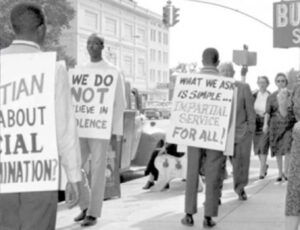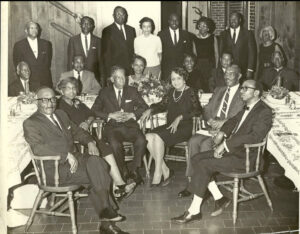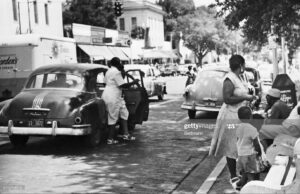
Photo courtesy sccopnest.com
The first time Charles J. Parrish rode on a Tallahassee city bus was in 1965, nine years after the highly publicized Tallahassee bus boycott began. Yet he was among the group of civil rights foot soldiers who were at the forefront of the movement. It was a movement that appears distant for some and for others it’s like it happened yesterday.
Parrish, who in 1956, when the boycott took place, was only in the ninth-grade at Lincoln High — an all-Black school in segregated Leon County. Although Parrish was unfamiliar with the segregated nature of the city bus he knew a change was in order when two Florida A&M University students, Carrie Patterson and Wilhelmina Jakes, were arrested for attempting to “incite a riot.”
FAMU students, following their arrest, initiated a bus boycott against the Tallahassee bus company, a charter largely patronized by the city’s bBack residents. Among those residents was the Rev. Henry Steele, the son of the Rev. C.K. Steele, a noted national civil rights activist who similar to Parrish had an early introduction to the movement.
“The bus boycott was probably the most significant time in my life. I was quite young so being involved in the movement at that age (12) was for me very significant. It was almost the beginning of the contemporary fight for freedom,” Steele said.
Jakes and Patterson prior to being detained had sat next to a white woman after entering a Tallahassee city bus. They refused to move to the back of the bus when instructed to by the driver. The two were arrested after the driver pulled over and called the police.
The Tallahassee bus boycott lasted seven months and led to two bus suspensions.
Unlike its predecessor, the Montgomery bus boycott, the boycott did not have the social and financial backing of the National Association for the Advancement of Colored People at the time. The movement was directed by the Inter-Civic Council and Steele’s father, C. K. Steele, the chair of the council.

“The NAACP went underground and Steele formed the Inter-Civic Council. At the time the acting Gov. Charlie John wanted to find out who were members of the NAACP and requested the names of teachers primarily. So during their state conference NAACP members sent all of the NAACP information to the headquarters and ceased their operations,” Parrish said.
FAMU was nearing the end of the spring semester when the boycott was organized so the movement would have staggered if not for the leadership of the council. Devised largely by Black ministers and entrepreneurs — the individuals who did not rely on the government for employment — the council remained steadfast as students returned home.
“The Black church was a very critical part of the movement, more so than the NAACP at the time,” said John Due, a civil rights attorney.
“The movement began as a church movement, rather than a legal movement. The NAACP was an organization of attorneys therefore, the NAACP had a culture of not violating the law. Attorneys were scared because they could be suspended and dismissed from practicing the law,” Due added.
Residents and the ICC also created an ultimatum for the bus charter requesting integrated seating, courteous drives and employment opportunities for Blacks. If the council’s demands were met then residents would continue riding the bus. Their ultimatum fell on deaf ears so the ICC formed car pools consisting of 65 volunteers willing to transport other residents to and from work. The car pools were successful until the attorney general ruled the carpools as a violation of Florida law.
Tallahassee, at the time was no stranger to social inequality. The city was among countless American cities that enforced Jim Crow laws, policies that divested African Americans of their civil rights. States below the Mason Dixon line, such as Florida, were notorious for placing Black residents into a caste society of second class citizenship.
“Separate but equal” was the unwritten rule in Tallahassee.
Public restrooms, water fountains, businesses and restaurants were all segregated and prohibited Blacks from utilizing ‘white only’ facilities. Hence, the bus boycott helped to mobilize the civil rights movement in Tallahassee.
The boycott continued on for the remainder of 1956 inducing several city ordinances including assigned seating, the employment of Black bus drivers and an appointed integrated committee. Yet, the city of Tallahassee refused to implement integrated seating even after the Supreme Court ruled segregated seating unlawful in June of 1956.
After the ruling, bus drivers began allowing Blacks to sit where they pleased and Tallahassee officials threatened the company’s charter further encouraging the Black community to continue boycotting the bus.

“We cannot be content with the condition here in the south, any longer. Our very souls are being taken from us by discrimination,” wrote Patricia Stephens Due, a civil rights activist, in her book “Freedom in the Family.”
The council reached a milestone when its final tactic proved successful. Six student, three Black and three white, from both FAMU and Florida State University, boarded a city bus on Jan. 19, 1957, and sat in a segregated fashion. Then Joe Spagna, one of the white students, switched seats with one of his Black companions, Leonard Speed and Johnny Herndon, leading to their arrest.
Even though the case was denied, the appeals went all the way to the Supreme Court and the charter company eventually ceased the enforcement of segregated seating.
This led to Black residents to resume riding the bus.
The impact of the Tallahassee bus boycott is more relevant, now than ever amidst the current culture and protests taking place across the country, including in Tallahassee.
“I think the protesters today are an extension of what we did back in the 1950s. I think they are doing a good job. I’d like to see them continue and not only protest, I think young people need to run for office and ensure they registered to vote,”Parrish, who went on to teach in Gadsden County for many years before retiring, said.
John Lewis, a civil rights activist among the “Big 6” who led the march on Washington, once talked about getting in “good trouble.” The kind of trouble that civil rights foot soldiers such as Steele and Parrish, have experienced and that a new generation is pursuing today.
“Clearly, there is still much to do in regard to eradicating systemic racism in America and other parts of the world. But, the beauty is that these civil rights pioneers would be proud of this expanding ‘people movement’. It’s about a change of heart and people are starting to change their hearts and minds,” said Elizabeth Dawson, former director of the Meek-Eaton Black Archives Research Center and Museum.